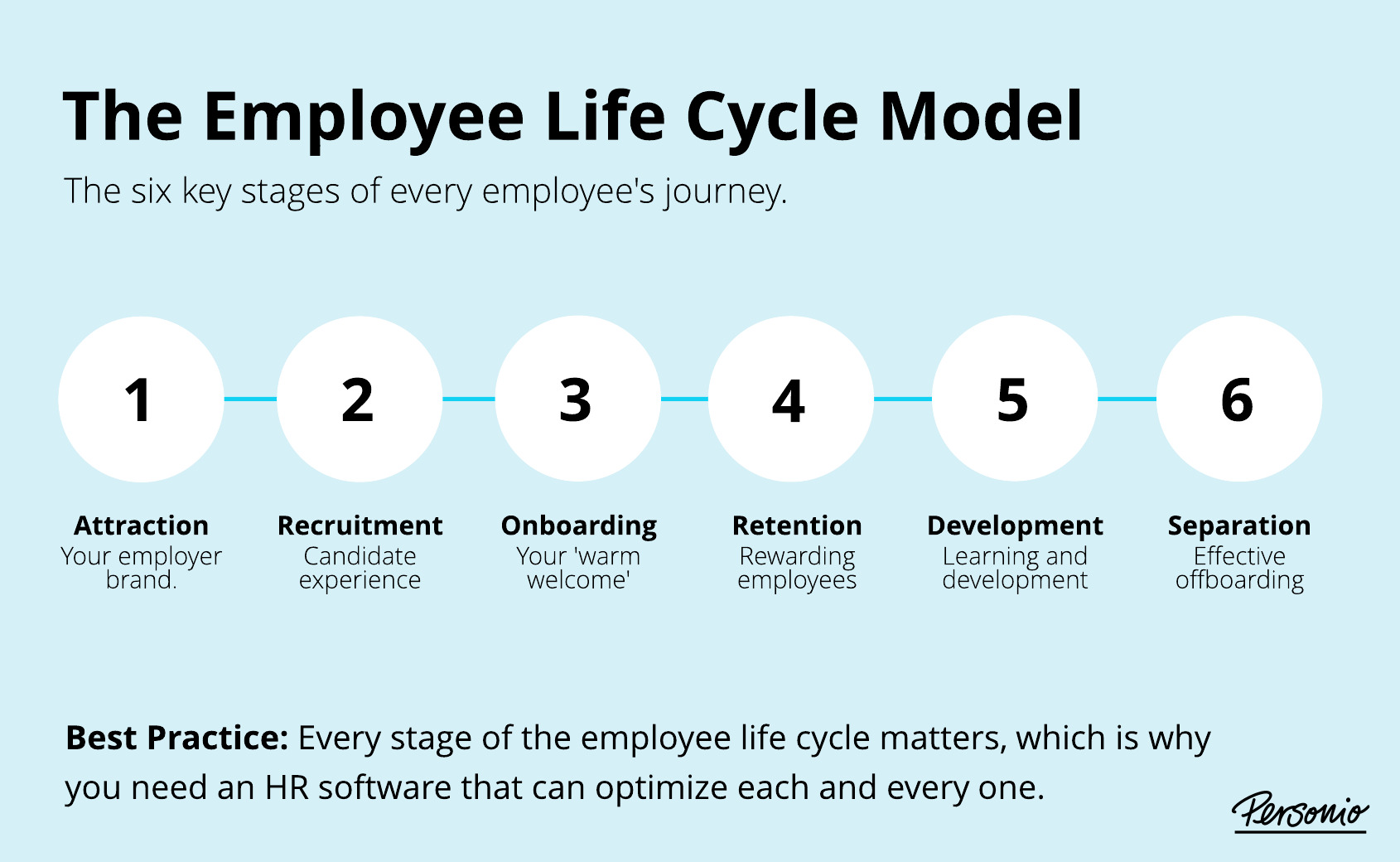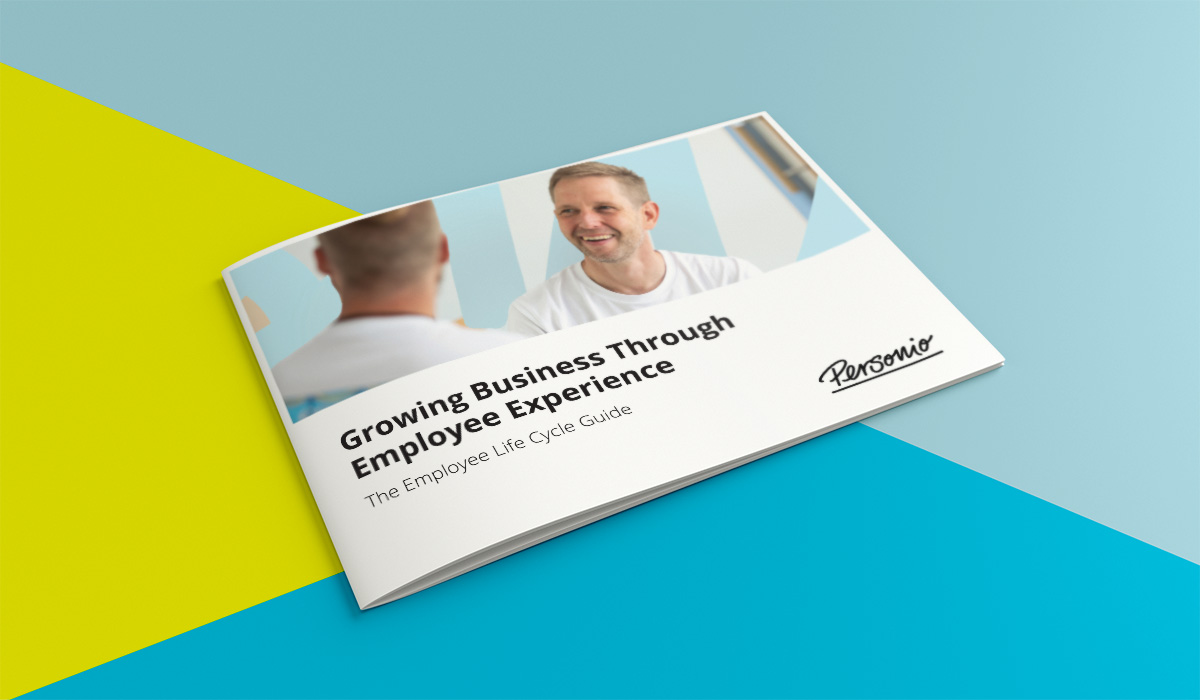The progression of staff through the employee life cycle is almost as inevitable as the changing of the seasons. But, why does this matter for organisational success?
In this article, the employee life cycle allows HR leaders to help employees realize their full potential. On the flip side, being aware of the cycle also helps companies be aware of, and manage, staff turnover risk.
Download our guide to get to the heart of the employee life cycle model.
Contents
What is the Employee Life Cycle?
What Are the Stages of the Employee Life Cycle Model?
The First Impression: Attraction
Getting Top Talent On Board: Recruitment
The Flying Start: Onboarding
Making Top Talent Stick: Retention
Never Stop Growing: Career Development
All Good Things Come To An End: Separation
How Critical is the Employee Life Cycle?
What is the Employee Life Cycle?
The employee life cycle model is used to identify and express the various and most important stages that an employee goes through as they engage with their company. There are six distinct stages at play: attraction, recruitment, onboarding, development, retention and separation. An employee passes each stage chronologically.
What Are the Stages of the Employee Life Cycle Model?
As mentioned above, there are six key stages that exist in the employee life cycle model. But, there are also some additional stages worth noting. Let’s take a look at the full picture:
| Stage | Definition |
|---|---|
| Attraction | The very second a potential applicant is exposed to your employer brand. |
| Recruitment | The process and experience of how someone goes from applicant to employee. |
| Onboarding | Helping employees understand and blend in with your corporate culture. |
| Retention | Keeping employees around and satisfied with relevant rewards and recognition. |
| Career Development | Helping employees get better in their roles through a variety of initiatives. |
| Seperation | The process of what happens when an employee inevitably decides to move on. |
1. The First Impression: Attraction
Your relationship with an employee doesn’t start the moment they arrive at the office. It doesn’t even start when they sign an employment contract or apply for a job. It starts the very second they are first exposed to your employer brand.
That’s why great HR leaders know that instilling the right corporate culture is critical. If you use the cultural web model, for instance, it’s possible to see how organizational structures, systems, rules, stories and symbols influence the way employees then interact with each other.
The next step is to showcase this culture to the rest of the world! Prospective employees will have chosen you for many reasons: including salary, job title, and job fit. But they will also have chosen to apply because your brand (and purpose) resonates uniquely with them.
Click here to watch our recent webinar on the topic of talent attraction.
Key Tip: Attraction Phase of the Employee Life Cycle
Endorsements from current or former staff members are priceless. That’s why GlassDoor is so popular. But savvy future employees will also check out your equality and diversity policies, approach to mental health at work, policies on maternity leave and factor in your attitudes toward overtime, sick pay, unpaid leave and even work-life balance (if you make this information available publicly).
2. Getting Top Talent On Board: Recruitment
The next stage of the employee life cycle is recruitment. This is important whether you do this the old-fashioned way or use tools to help you manage the recruitment process.
That’s because how well you treat prospective employees during this journey (even the ones who don’t get the job) will influence their perception of your company forever.
Key Tip: Recruitment Phase of the Employee Life Cycle
- Advertise positions on multiple platforms to entice a wider spectrum of candidates. The fewer channels you use, the narrower your chance of reaching great candidates. Going wide is great – but don’t forget the value of your internal talent pool who might be looking for a promotion or a sideways step. Also, consider the efficacy of employee referral programs. Here, multiposting may be also something of a silver bullet.
- Make your job adverts effective. A great job advert does more than list individual core attributes and skillsets. It entices people and attracts them to your employer brand. Make sure you outline the available benefits – from medical cover to staff discounts and even days off for volunteer work.
- Ensure your time is never wasted. We recently profiled two key best practices that factor into the recruitment process: managing the offer stage and maintaining exceptional offer acceptance rates, as well as speeding up hiring by as much as 40% for critical roles. After all, time is a crucial resource when it comes to recruiting.
3. The Flying Start: Onboarding
It’s natural to be excited when you start a new job. There’s a sense of optimism and potential. That’s why this is the ideal time to make people feel welcome, safe and already at home.
Getting this right will help new recruits feel like they have the potential to make their mark on the organisation.
Onboarding is about helping new employees blend in with your corporate culture and truly become part of the team. One way to do this is to make sure you’re identifying and communicating company core values.
A good onboarding process for new employees also goes a long way!
Key Tip: Onboarding Phase of the Employee Life Cycle
-
- Make sure there’s a regular appraisal system. A good staff appraisal can help get the best out of your team. While it might be too soon, right in the first few weeks, to think about measuring performance already – the system should be introduced so employees know what’s expected of them, and how they will be rewarded for excellent work.
- Show them a clear path to success. One of the secrets of a successful performance management cycle is that they help align employee goals with business goals on a short and longer-term basis.
- Share your company values, vision, and mission. For example, at Personio our values include customer empathy, ownership, transparency, team spirit, social responsibility and fun.
Download: Our Brand New Employee Life Cycle Guide
Take your HR work to new heights by growing business through the lens of the employee life cycle model.
4. Making Top Talent Stick: Retention
This is a key stage of the employee life cycle. That’s because once employees have been with a company for a while, there’s a real risk that employers might start to take them for granted.
That’s why it’s important to address thorny issues such as rewards and recognition as soon as possible. Then, over time, it’s important to make sure employees know what to do to help achieve their goals, as well as what HR needs to do to keep accurate records of their ambitions, progress and success.
Key Tip: Retention Phase of the Employee Life Cycle
- Over time, it’s wise to consider how to improve employee retention and boost retention rates. When employees aren’t completely happy, it’s often good to take a look at ways of boosting employee motivation.
5. Never Stop Growing: Career Development
Once employees are settled and happy it’s also worth considering how strategic professional development can help you get the best out of your employees.
Key Tip: Career Development Phase of the Employee Life Cycle
- Offer a buddy system. When experienced colleagues share their knowledge, this allows the effective dissemination of both corporate culture while giving new employees support, access to a trusted advisor and a go-to-point for asking those questions that seem stupid (but usually aren’t).
- Encourage people at all stages to learn more. Whether it’s internal or external learning and development (L&D): conferences, seminars and ‘lunch-and-learns’ keep employees up to date with new trends while expanding their knowledge. If they can share their learnings with the rest of the team and make improvements based on new knowledge, it’s a win-win for all!
- Sponsor or subsidize courses for those who show promise if the budget allows for it. Nothing shows a company cares for its staff more than investing in their training, education and learning.
6. All Good Things Come To An End: Separation
Eventually, employees decide to move on. At this stage of the employee life cycle, there are many factors at play. For example, former employees might move or look for career opportunities that they can’t get at your company, they might retire, go off to work for themselves or even be enticed away by a rival company.
At this stage, reflection is essential. Having a good offboarding process helps you understand where there is room for improvement in the employee experience (it’s probably the time you’ll get their most honest opinions). It may also bring up key considerations about how you formulate employment contracts or gardening leave policies.
But don’t forget: the separation phase of the employee life cycle doesn’t just affect those leaving, it affects those left behind. Helping them feel like they’ll be supported, even when the team member is gone or giving them the opportunity to be involved in the new recruitment process (if applicable) can help ease the pain.
There’s another way of looking at a beloved employee’s departure, too:
Try thinking of them as brand advocates, even if they’re no longer employees. If it fits your culture, you might want to send them cards or emails during the festive season, continue to invite them to corporate functions or reach out to them when you’re hiring for new roles to ask them if they know people.
That way, employees become ‘graduated alumni’ of your organization. If they remember you with fondness and kindness, the relationship can continue for many years!
How Critical is the Employee Life Cycle?
The employee life cycle is the bread and butter for organisational success. After all, every phase of an employee’s journey with a company provides its own opportunity to improve the employee experience.
That can have a cascading effect on attraction, recruitment, development and retention. When you see your people through the lens of the employee life cycle model, you can manage a healthier and more successful workforce.
What does each life cycle phase look like at your company? Do you currently have challenges attracting, managing, developing or retaining your top talent?
In that case, let one of our experts at Personio know by booking your very own web demo today. In it, we can talk about your common roadblocks and how to solve them with HR software.
Take Your HR
To New Heights






